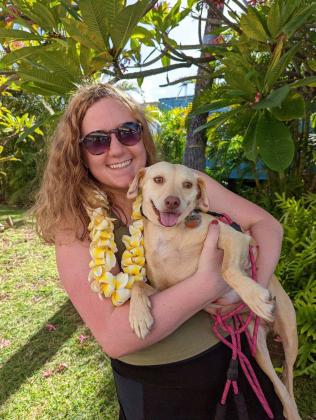Mariah Yelenick’s students vary in background and age but share one thing: They’re incarcerated. The MITRE Hawaii-based data scientist says teaching in a prison has taught her far more than she expected. She spoke with Karina Wright about the value of education, her path to MITRE, and how she landed on Oahu.

Digital Literacy as a Springboard to Change

As a teaching assistant in college, I helped write curriculum for and teach an introductory Java programming course. The classroom was in a men’s medium-security prison in Missouri, near my school, Washington University in St. Louis. Everyone there worked harder than any other students I’d taught.
My teaching stopped when COVID shut everything down toward the end of my senior year. I moved home, graduated remotely, and felt extra grateful that I had a job lined up with MITRE. It was at the Grace Hopper Celebration [for women in computer science] where I learned about MITRE. I started in June 2020 in Illinois, and later worked in McLean.
The pandemic was still active, so volunteering wasn’t an option. I used the time to focus on a master’s degree in data analytics and policy from Johns Hopkins. MITRE’s educational assistance benefit made it possible to balance work and studying.
An email from the MITRE Honolulu team dropped in my inbox that winter: “Are you sick of the snow? Want to work in Hawaii? Contact us.” I sent probably 20 messages!
I moved to Oahu in May 2022 as part of our Push to the Pacific initiative. Most of my work here supports the DoD, using simulation, modeling, code, data analysis, data science, and machine learning to help secure the region.
Foundation for a New Start
After I got settled in Hawaii and finished my master’s, I wanted to start teaching again. I contacted the director of education for the Hawaii Department of Corrections, who said I could teach whatever I wanted if I was willing to volunteer. When I proposed a programming course, she said I’d first need to show students how to use a computer.
I found that students didn’t take anything for granted. A cancelled class meant missing a chance to learn skills to get a job and better pay after being released—and beat the odds of recidivism.
The 10 students in my inaugural digital literacy class had different levels of technology experience. They were ages 30 to 70 and many had been in prison for 10, even 20 years. Some were from other Polynesian islands, where it’s even more disconnected from the internet. Many had heard about ChatGPT from the news but didn’t know the difference between left and right clicks or how to apply for a job online.
I began with devices: How do you use them? How can you use these tools to better yourself, both in prison and when you’re released?
The classes were in the evening after work, but it helped that I could use volunteer hours when I needed to grade assignments or plan lessons before class.
A Path to Opportunity
Teaching in a prison is very different from teaching on a college campus. There are no office hours. Students can’t Google answers. They don’t have internet or laptop access outside of class. I printed out a ton of resources for my students to read in between classes.
Keeping people’s minds engaged is half of the benefit. It shifts their priorities, which is an underrated part of education in prison.
A student who was working as a line cook in the prison kitchen offhandedly mentioned that he got promoted to a supply manager. He also got a raise because he could use Excel—which he learned in my class—to track shipments and inventory.
I found that students didn’t take anything for granted. A cancelled class meant missing a chance to learn skills to get a job and better pay after being released—and beat the odds of recidivism.
For anyone looking to learn more about these programs, I recommend the PBS documentary, College Behind Bars.
Fostering the Next STEM Generation
My Honolulu colleagues also share their STEM expertise. There are about 40 of us on Oahu, and we've formed this really nice ohana [family]. We’re developing local talent in high schools and universities so that graduates can stay close to their ohana and community, while having a rewarding technical career.
I helped lead our summer intern program. Four of our five interns were from Hawaii. Getting them involved with MITRE and our local sponsors was a great way to start them thinking about how MITRE might fit into their post-graduation plans.
Interested in solving problems for a safer world? Join our community of innovators, learners, knowledge-sharers, and risk takers. View our Job Openings and Student Programs. Subscribe to our MITRE 360 Newsletter.